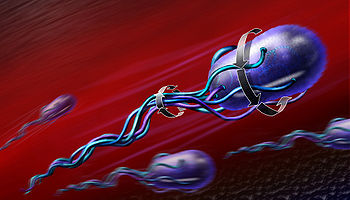Scientists have developed the cellular equivalent of a shrink-wrapping system which is capable of packaging up chemicals inside the cell.
Writing in Science, Zurich-based researcher Donald Hilvert and his colleagues added a gene encoding the enzyme lumazine synthase to E. coli bacteria. This enzyme, borrowed from another bacterium that inhabits hot springs, is normally involved in the synthesis of one of the B vitamins. But it also self-assembles into hollow, 20-sided icosahedral cages or "capsids" capable of carrying a cargo.
The breakthrough achieved by the Zurich team was to "functionalise" the cages so that as soon as they were assembled inside a cell, they would automatically grab a specific chemical and package it inside themselves. This was achieved by altering a small number of the amino acid building blocks from which the cages are built to give them an additional negative charge. Then, by adding a positively-charged chemical group to the substance they wanted to sequester inside, the electrical attraction between the two took care of the rest.
achieved by altering a small number of the amino acid building blocks from which the cages are built to give them an additional negative charge. Then, by adding a positively-charged chemical group to the substance they wanted to sequester inside, the electrical attraction between the two took care of the rest.
The concept was proved by also adding the gene to the same E. coli for the protease enzyme made by HIV. This is normally toxic to any cell that makes it, but by locking it away inside the molecular cage inside the cell, the bacteria could safely make and package the substance without harm.
Even better, as the bacteria grew over a series of generations, they naturally evolved to become 10 times better at doing the task. This trick, say the researchers, is the first step towards designing bespoke molecular cages that can be used to package biosynthesised substances, including chemicals that have previously proved difficult for reasons of toxicity or stability, or are troublesome to purify.










Comments
Add a comment